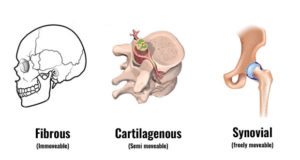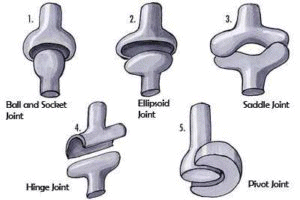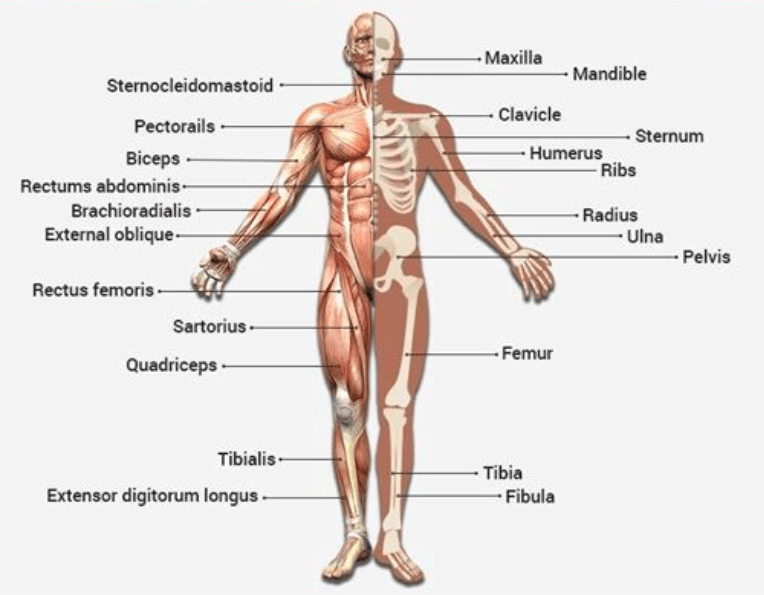Skeletal System, Joints & Disorders | Biology Class 11 - NEET PDF Download
Introduction of Skeletal System
The skeletal system provides a structural framework and supports the body. It is made up of 206 bones in an adult human. It comprises of bones, cartilage, ligaments and tendons that connect to bones and bones to muscles. The human skeletal system provides definite shape to the body and protection to internal organs. At the time of birth, infants have more bones (~300 bones), which due to fusion in some of the bones, form larger bones and 206 bones remain in a human adult.
Functions of Bones
- Bones provide shape to the body.
- Bones act as a protection to internal organs like brain, heart, lungs etc..
- Provides support to the body and anchors muscles.
- Bones serve as storage space for minerals like calcium and phosphate.
- Bones helps in facilitating body movements.
- Bones serve as the birthplace for red blood cells.
Human skeletal has two major divisions
- Axial skeleton
- Appendicular skeleton
The axial skeleton is made up of 80 bones and it constitutes the middle axis. It includes the following regions:
- Skull
- Hyoid
- Auditory ossicles
- Vertebral column
- Ribs
- Sternum
- Skull: The human skull consists of cranium and facial bones. The function of the cranium is to protect the brain. It is formed of 8 plate-shaped bones joined together at meeting points called sutures. Along with cranium, the remaining 14 bones form the facial bones. Mandible is the only movable bone in the human skull.
- Hyoid: It is a U-shaped bone located in the anterior neck. It is an intermediary between the skull and post cranial skeleton. The hyoid bone aids tongue movement and swallowing. It has no articulation with other bones.
- Auditory: Ossicles Auditory ossicles namely malleus, incus, stapes are three bones in the middle ear that are the smallest bones in the human body. The functions of ossicles are to transmit sound from the air to the cochlea.
- Ribs: Ribs are the long curved bones which constitute the rib cage. The ribs consist of 24 bones in 12 pairs which form the protective cage of the thorax. The ribs protect the thoracic internal organs. They articulate posteriorly with the vertebral column and terminates anteriorly as cartilage.
- Sternum: Sternum or the breastbone is a long bone placed at the central part of the chest. The sternum and ribs make up the rib cage. The sternum is attached to the first seven ribs and also to the Clavicle or collarbone.
Vertebral Column
The vertebral column is a set of approximately 33 bones called vertebrae which are separated by intervertebral discs. The vertebral column is divided into 5 categories. They are Cervical, Thoracic, Lumbar, Sacrum, Coccyx.
- Cervical Vertebrae: The cervical is the most delicate and the thinnest bones of the vertebral column. The cervical vertebrae are formed of 7 vertebrae. The seven cervical vertebrae are arranged along the length of the neck. They are named according to its position from the skull to the chest. The superior C1 or first cervical vertebrae to C7 or the seventh cervical vertebrae constitute the cervical vertebrae. The C1 vertebrae are named as Atlas whose function is to hold up the skull. Also, C2 is named as Axis since it serves as the axis for the skull and atlas to rotate while turning head from one side to another.
- Thoracic Vertebrae: It is placed at the mid-back of the human body. The main function is to hold the rib cage and to protect the heart and lungs. The twelve thoracic vertebrae are named T1 to T12. Thoracic vertebrae are the unique one other than the remaining vertebrae as it supports the ribs.
- Lumbar Vertebrae: These are the largest in the vertebral column and comprises of 5 vertebrae bones between the rib cage and pelvis. The lumbar vertebrae are named from L1 to L5. L1 is closest to the thoracic vertebrae whereas L5 is adjacent to the pelvis. The lumbar vertebrae functions as the load-bearing structure.
- Sacral Vertebrae: The sacral vertebrae consist of 5 vertebrae bones which fuse together to form Sacrum. The sacrum is a long wedge-shaped vertebra at the inferior end of the spine. It is a very strong bone which supports the weight of the upper body as it spread across the pelvis into the legs.
- Coccyx Vertebrae: The coccyx vertebrae are formed by the fusion of three to five rudimentary bones to form a small triangular bone at the bottom of the vertebral column. The coccyx vertebrae are also referred to as the tail bone. The coccyx serves as an attachment site for ligaments, tendons and muscles. The coccyx may be fractured when a person falls abruptly.
Functions of the Vertebral column
- The vertebral column protects the spinal cord.
- Provides stiffening to the body.
- Provides structural support by balancing the bodyweight.
- Provides attachment to pectoral and pelvic girdles and other muscles.
Appendicular Skeleton
The appendicular skeleton is the part of the human skeletal system that supports the appendages. It consists of 186 bones including the bones of the limbs as well as supporting the pelvic and pectoral girdles.
The appendicular skeleton is divided into 6 regions:
- Shoulder girdle
- Arms and forearms
- Hands
- Pelvis
- Thighs and legs
- Feet and ankles
- Shoulder Girdle
The shoulder girdle or the pectoral girdle is a set of 4 bones which connects to the arm on each side. The pectoral girdle is part of the appendicular skeleton which are for the upper limbs. In human beings, the pectoral girdle consists of the scapula and the clavicle. - Arms and Forearms
The arm and forearm are constituted of 6 bones. The large bones of the arm include:
(i) Humerus: Humerus runs from the shoulder socket and joins the radius and ulna at the elbow.
(ii) Radius: Radius is a forearm which runs from the elbow to the thumb side of the wrist.
(iii) Ulna: Ulna, a forearm which runs from the elbow to the ‘pinky’ side of the elbow. - Hands
The hands consist of 54 bones which provide support and flexibility to the soft tissues. The bones of hands are categorised into three:
(i) Carpals: Carpals are a set of 8 irregularly shaped bones located in the wrist area.
(ii) Metacarpals: Metacarpals are bones which are related to each digit, there are 5 metacarpal bones.
(iii) Phalanges: Phalanges are the bones of the fingers. There are 3 phalanges in each finger, except, for the thumb which has two phalanges only. - Pelvic Girdle
The pelvic girdle is located in the lower part of the trunk. It a ring-like bony structure. The pelvic girdle consists of two bones sacrum and the coccyx. The pelvic girdle is formed of paired hip bones each made up of ilium, ischium and pubis. - Functions of Pelvic Girdle
(i) It transfers the weight of the body from the axial skeleton to the appendicular components, especially during the movement.
(ii) Provides attachment from a number of muscles and ligaments enabling movement. The majority of women have a gynaecoid pelvis and males have an android pelvis.
The differences in the structure creates a great pelvic outlet enabling the process of childbirth. - Thighs and Legs
The bones of the legs and thighs are part of the appendicular skeletal system which supports the muscles of the lower limbs. These muscles help in walking, running, standing and jumping. These bones should be strong enough in order to support the body’s weight.
(i) The Femur or thigh bone is the largest and heaviest bone in the human body. At the proximal end of Femur, there is a rounded prominence which is called as the Head of the Femur.
(ii) The Tibia and Fibula are the two long bones in the lower leg. They are two separate bones but are closely linked at the knee and the ankle.
(iii) The top of Tibia connects to the knee joint and bottom connects to the ankle joint. Although Tibia carries all the body weight, it needs the support of Fibula. - Feet and Ankles
The foot is a firm platform which supports the weight of the body. It is formed of many bones such as the tarsals, metatarsals and phalanges.
(i) Tarsals: A set of 7 irregular bones situated proximally in the foot in the ankle area.
(ii) Metatarsals: A set of 5 bones each one for a digit. These bones connect tarsals with the phalanges.
(iii) Phalanges: Each toe has 3 phalanges namely the proximal, intermediate and distal.
Tendons: Tendons joint bones to skeletal muscles. They are made up of connective tissues.
Ligaments: Ligaments join two bones together. They are also a type of connective tissue.
Cartilage: Cartilage provides protection of bones at the joints from wear and tear. They are firm yet softer and flexible than bones.
It forms a structural framework of many parts of the body, e.g. ear, nose, ribs, bronchial tubes, etc.
Diseases Related To Skeletal System
- Osteoporosis: Osteoporosis is a bone-related disease in which the bone density is reduced and increasing the risk of bone fracture.
- Paget’s Disease: It is a chronic bone disease which causes the affected bones to large and misshapen.
- Arthritis: It is the inflammation caused to the joints causing difficulty and pain in movements and limiting the same.
Introduction to Joints
Joints aka articular surface can be defined as a point where two or more bones are connected in a human skeletal system. Cartilage is a type of tissue which keeps two adjacent bones to come in contact (or articulate) with each other. 3 Types of joints are Synovial Joints, Fibrous Joints, and Cartilaginous Joints. Joints help in bringing about movements in different parts of the body. Let us see the classification of joints and the anatomy of different types of joints.
Classification of Joints
Joints can be classified in different ways depending on:
- The amount of mobility permitted by the joints
- Type of tissue connecting the bones
Each of these types can be further subdivided. Let’s look at each classification individually.
1. The amount of mobility permitted by the joint
- Fixed Joint or Synarthroses: The word ‘syn-‘ tells us that the bones are fused and therefore permit minimal or no movement. These joints are fibrous joints which means that the binding tissue between two bones is ‘fibrous’ in nature. Example of a fixed joint is the sutures between skull bones.
- Slightly Movable Joint or Amphiarthroses: This joint permits slight mobility that is more than what is seen in a fixed joint. The binding tissue in this type of joint is cartilaginous in nature. Example of a slightly moveable joint is those found between intervertebral discs.
- Freely Moveable Joint or Synovial Joints: These joints permit maximum movement between the bones involved. They are also called as ‘diarthroses’ and are further classified into 6 types depending on the kind of movements possible.
Types of Synovial Joints
- Ball and socket joint: This kind of joint involves two bones. One of the bone has a large rounded end which fits into a cup-like socket of the other bone. This kind of joint is generally found in large bones such as the shoulder joint and hip joint. A ball and socket joint provides the greatest degree of movement among different kinds of joints including rotation, flexion, extension, abduction, and adduction.
- Hinge joint: This joint is said to be a very simple joint that allows movement only in one axis. It allows only two kinds of movements- flexion and extension. Example of this joint is the joints found between in the elbow and knee.
- Pivot joint: This type of joint allows rotation along one axis only. A common example of this type of joint is the atlantooccipital joint in the neck.
- Ellipsoid/gliding joint: This joint is very similar to the ball and socket joint but without rotation. It allows movements only in two axes. Example of this is the wrist joint.
- Saddle joint: It is similar to an ellipsoid joint which involves two bones- one of the bones has a convex surface while the other has a concave surface. The convex surface of one bone articulates with the concave of the other to allow limited rotational movement. A very classic example of this kind of a joint is the carpo-metacarpal joint in the thumb.
2. Type of Tissue Connecting the Bones
Based on the type of tissue connecting the bones, we can classify joints as:
- Fibrous: The tissue connecting the two bones is fibrous in nature.
- Cartilaginous: Cartilage forms the connecting tissue between two or more bones.
- Synovial: The two bones form a synovial cavity with synovial fluid which forms the connecting tissue.
Apart from movement and locomotion, joints also help stabilize the different parts of the body.
Introduction
The human body is a well-oiled machine that has numerous components and functions that work in conjunction with each other to keep this machine in good operating condition. One of these parts is the muscular and skeletal system. In this informative piece, we will discuss Muscular and Skeletal Disorders.
The Musculoskeletal System Musculoskeletal System
Musculoskeletal System
This musculoskeletal system consists of muscles, ligaments, joints, tendons, connective tissue, bones, etc. The muscular system permits movement of the body, maintains posture, circulates blood and so on. Without the skeletal system or in the absence of bones the whole system would collapse and end up being a pile of tissues. Therefore, it can be understood that one cannot debate the importance of one component over the other.
Muscular and Skeletal Disorders
A disorder can be defined in layman terms as a deviation from an order or an abnormality. This disorder can afflict any machine or human body. The human body, like most machines, undergoes wear and tear over time, because of age or misuse. This wear and tear lead to disorders. The muscular and skeletal system is also subject to diseases and this affects the human body adversely. Below are mentioned a few Muscular and Skeletal Disorders. Osteoporosis
Osteoporosis
List of Disorders
- Myasthenia gravis: It is the abnormal weakening and rapid fatigue of certain muscles. It is due to a breakdown in communication between nerves and muscles.
- Muscular Dystrophy: This is mostly hereditary. It causes progressive weakness and degeneration of skeletal muscle, which controls movement.
- Tetany: It is caused due to low blood calcium and is characterized by rapid or wild spasms.
- Arthritis: Inflammation of one or more joints. Arthritis leads to the limited movement of joints and pain.
- Osteoporosis: The chances of contracting this disease increases with age, resulting in reduced bone mass and fragile bones, thus increasing chances of fracture. Low levels of estrogen are a common cause.
- Gout: This too is the inflammation of joints, but due to an accumulation of uric acid crystals.
|
169 videos|524 docs|136 tests
|
FAQs on Skeletal System, Joints & Disorders - Biology Class 11 - NEET
| 1. What is the skeletal system and what are its main functions? |  |
| 2. What are the different types of joints in the human body? |  |
| 3. What are common disorders of the skeletal system? |  |
| 4. How do joints contribute to movement in the body? |  |
| 5. What are the symptoms and treatments for joint disorders? |  |





















